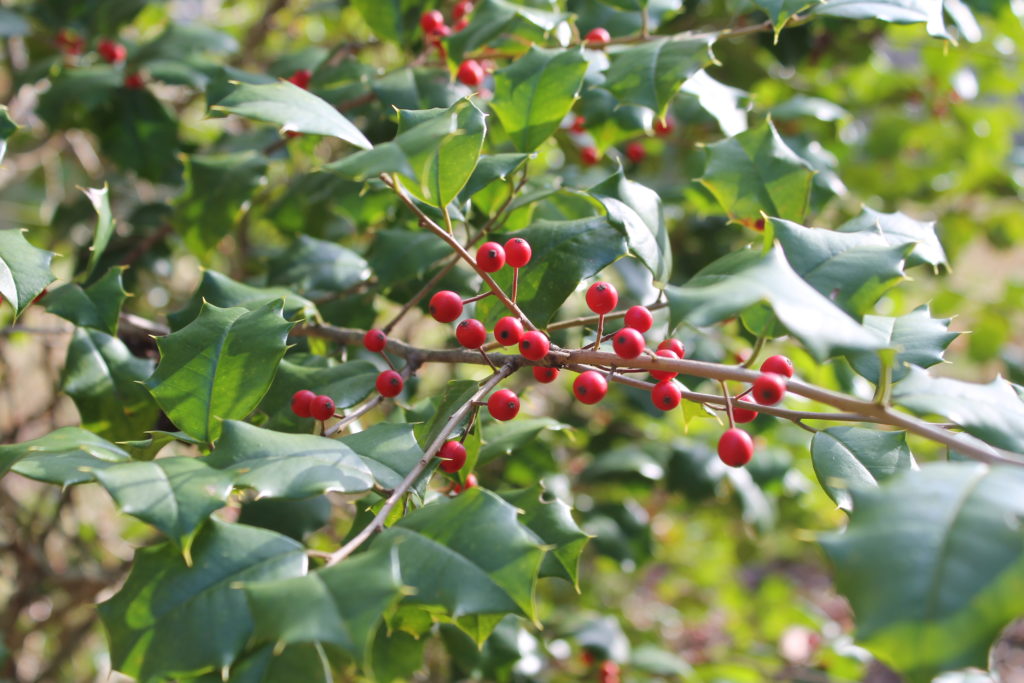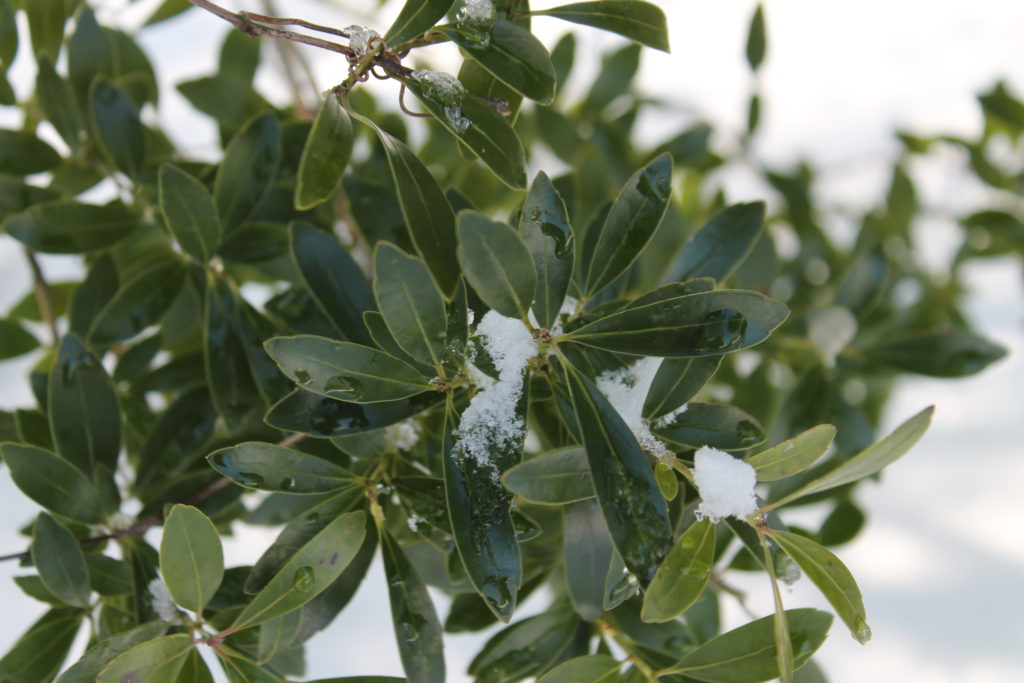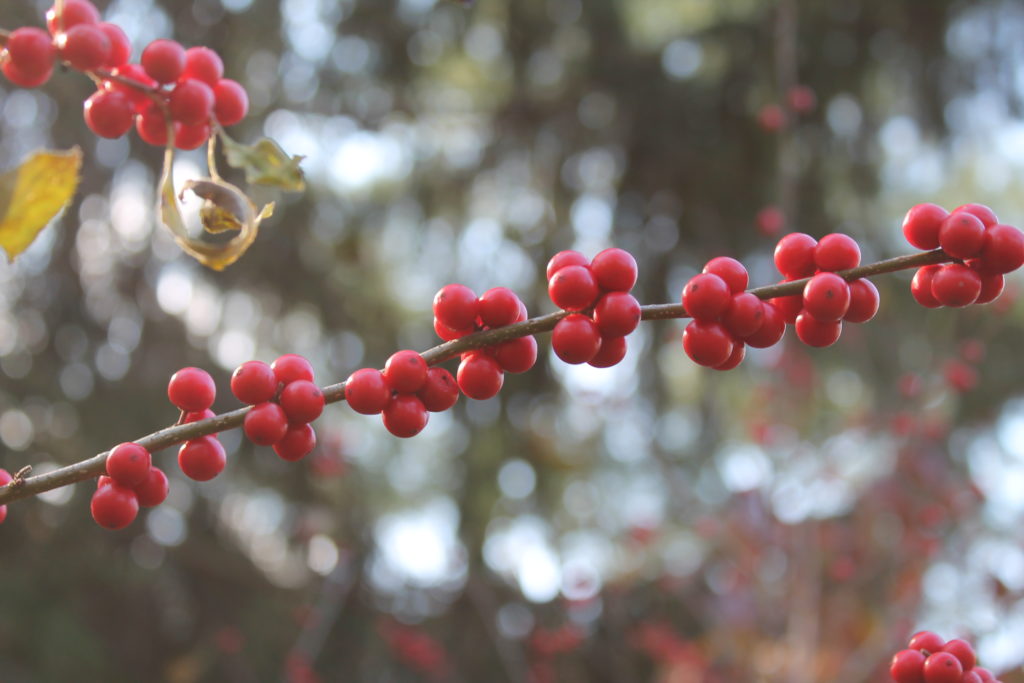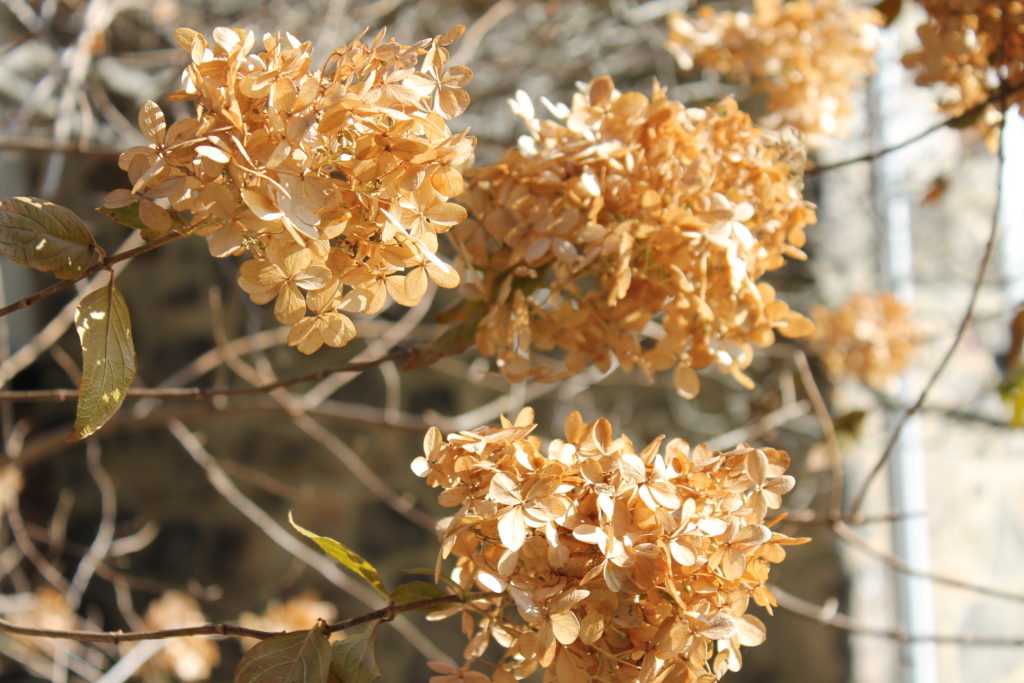When designing a garden in other seasons, it is easy to forget what your garden will look like in winter. Since this cold and sometimes dreary season is three months long, incorporate winter garden plants that perform while other plants are taking the season off. Select winter plants with evergreen foliage, interesting bark, colorful berries, and dried seed heads for a truly, year-round garden.
Evergreen Trees
Because of their size, evergreen trees are often difficult to fit into residential landscapes. Among these, American Holly (Ilex opaca), Eastern White Pine (Pinus strobus), and Eastern Hemlock (Tsuga canadensis) are native to our area. Although these trees reach over 80’ tall and 40’ wide, they are lovely if placed where they have room to grow. Beware of the pest, wooly adelgid, if you are considering Eastern Hemlock though. It is a major concern, and you may need to control infestations to keep your hemlock healthy.

Some smaller evergreen options are Foster’s Holly (Ilex x fosterii), Eastern Red Cedar (Juniperus virginiana), and Arborvitae. Foster’s Holly is a cross between Ilex opaca x Ilex cassine. Since both of these hollies are native species and hybrids occur naturally, include Foster’s Holly in your native plant list. It grows to about 30’ tall.
Eastern Red Cedar is an important food source for birds like robins and cedar waxwings. It is a wonderful tree, but avoid it if you have apples on your property because it is a host for cedar apple rust.
Include Arborvitae with with other plants in a mixed border. This is much more interesting than boring rows you find along edges of properties throughout suburbia. Its quick growth, soft texture, and narrow habit are all good reasons to include it in the landscape. Deer browse heavily on Eastern Arborvitae (Thuja occidentalis) so use Western Arborvitae (Thuja plicata) as a substitute.
Evergreen Shrubs
Native evergreen shrubs include Inkberry Holly (Ilex glabra), Rhododendron, Mountain Laurel (Kalmia latifolia), and Doghobble (leucothoe sp.). Of these, the Inkberry Holly is the most versatile, being very adaptable to different growing conditions. The next three plants are lovely, but more exacting culturally. They require rich, acidic, well-drained soil, and part shade to thrive.

Along with evergreen trees and shrubs, consider some evergreen plants on the ground layer. Christmas Fern, (Polystichum aristichoides), Golden Groundsel (Packera aurea), and native Allegheny Pachysandra (Pachysandra procumbens) all provide green throughout the year.
Native Trees with Interesting Bark
When walking through wild places in winter, one plant stands out above all others. It is the American Sycamore (Platanus occidentalis). While the bark of most trees crack as the tree gets older, the bark of the sycamore peels. This reveals white, newer bark underneath giving the tree a very dramatic, mottled appearance. The white trunks are especially evident in winter when there are no leaves on other trees. Sycamores naturally occur along streams, which makes them a great choice for wet or compacted soils.

Another tree with interesting bark is the Shagbark Hickory (Carya ovata). As the name implies, this hickory’s bark hangs in rough scale-like patches along the trunk, creating a very shaggy appearance. This bark is a great hiding place for numerous creatures, such as the mourning cloak butterfly. You are also apt to see birds like nuthatchs, or brown creepers inspecting the bark for something to eat.
Include other native shade trees such as River Birch (Betula nigra) with its tan, peeling bark, or shrubs such as Red-twig Dogwood (Cornus sericea) to the list. The shrub, Red-twig Dogwood grows quite large (6-8’ tall by 8-10’ wide), so give it plenty of room. Or, since the red twigs occur on new stems, cut it back to about 6” in early spring. This controls its size and maintains its striking red color.
Native Plants with Berries
Berries provide great color in the winter landscape and are also food for birds and animals at a lean time of year. Birds find some berries unpalatable until several freezes soften them. This is why they are not eaten earlier in the year. Among these winter gems are Winter King Hawthorn (Crataegus viridis ‘Winter King’), Crabapple (Malus coronaria cv.), Chokeberry (Aronia arbutifolia), American Beautyberry (Callicarpa americana), Winterberry (Ilex verticillata), and Northern Bayberry (Myrica pensylvanica). Fruit color can appear bright red, copper, bright lavender, and white in these plants.

Northern Bayberry is an interesting and underused native landscape plant. Birds relish the dark berries which are coated with a wax that causes a white appearance in winter. You can melt them down to make bayberry candles with that distinctive bayberry scent. Bayberries grow along the coast and are very salt tolerant. So safely plant bayberry along roads where salt is used.
And remember, with hollies and bayberries, you need both a male and a female plant in order to get fruit. Ask your local nursery expert which male holly is the correct pollinator plant for the female cultivar that you choose.
Native Plants with Interesting Seed Heads
Add interest to your winter landscape by including plants that look nice when dried. Oakleaf Hydrangea (Hydrangea quercifolia) is a fabulous four-season plant. Its large panicles of dried flowers turn from creamy white to an antique pink, and finally to a lovely tawny brown in winter.

The dark seed-heads of Black-eyed Susan (Rudbeckia fulgida) provide food for finches and other birds. They also look terrific by providing structure and contrast in your garden after a snow.
Include Milkweed (Asclepias sp.) which has interesting seed pods that can be used in decorating or in dried flower arrangements. Milkweed has the added benefit of being the host plant for Monarch butterflies.
Also, consider our native grasses, such as Little Bluestem (Schizachyrium scoparium), Purpletop (Tridens flavus), and Indian Grass (Sorghastrum nutans). They produce seed heads which feed birds, and are different shades of gold and brown in the winter garden.
And finally, decorate with these plants, both indoors and out to celebrate the winter season.
So, if you find yourself yearning to get outside in the winter months, create a winter garden and enjoy the outdoors all year long!

